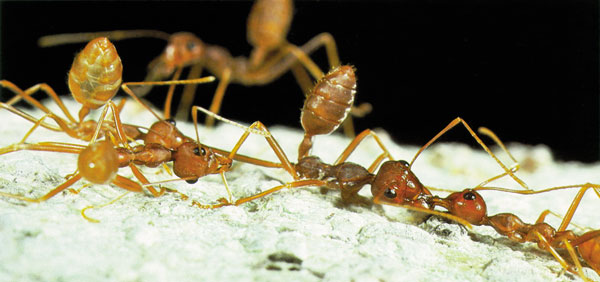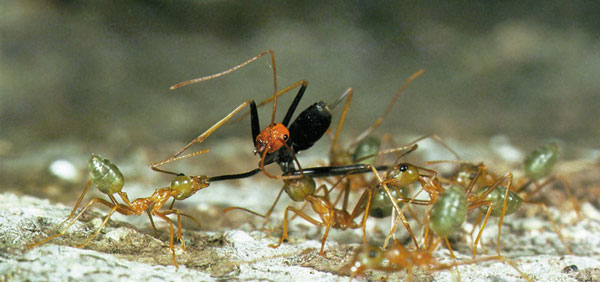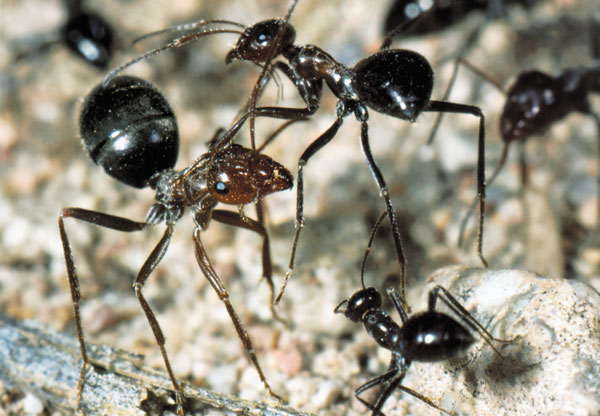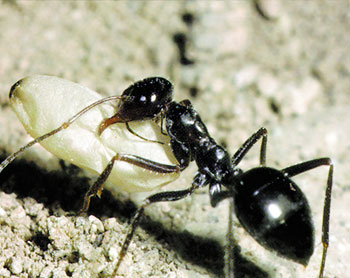Defence and War Tactics
In the previous chapters we have seen that the social order of ants is highly advanced. These hardworking, productive and sacrificing beings have yet another feature: They defend themselves very successfully against enemies and they use very interesting techniques to fight for the survival of the colony.
The small size of the ant at first gives the impression that they are defenceless. One cannot even imagine that these creatures, which can be crushed easily by stepping on them, can achieve tasks that seem far beyond their capacities. Yet, Allah within the unique ecological order He has created on earth has designated their place and has equipped them with the necessary defence mechanisms.
By Allah's inspiration ants use seemingly incredible tactics and strategies to defend their colonies and to protect themselves against the enemies that they meet during the search for food. While developing hunting strategies, they fight not to become a prey to others. One battle of this type is the one between the ant colonies.
War Between Colonies
One of the most important reasons for inter-colonial wars is the difficulty in sharing food resources. In such wars, the ant species that first finds the food source usually wins. This is because the discovering ants surround the food, thus preventing others from getting at pieces of the food. They also leave their odors around, so that members of the following colony cannot show the way by odor trails.
 |
While some of the workers that first reach the food source maintain the blockade operation, another group does not join the war immediately, preferring to return home, and leaving odor trails. When they arrive home, they warn their nestmates by moving their bodies back and forth, and touching the antennae of the other ants with their own antennae. With this smart tactic, reinforcements are gathered for the fighting workers. Apart from ordinary sieges during the day, the ants become so aggressive during a famine that they may destroy each other completely. One colony may destroy another completely within 10-14 days. Another cause of war is one colony entering the territory of another. Ants mark their territories with a pheromone. When another colony comes to the area, it notices this pheromone and normally does not settle here. But if it does, this will be a cause of war. In such situations, for instance, weaver ants run to the nearest leaf while leaving a secretion behind. When they find their nestmates, they tell them about the fight by their movements. Their mates start moving upon this invitation and travel towards the war zone following the workers. In half an hour, more than one hundred ants reach the arena.
 |
In short, ant colonies lead a sophisticated existence with their natural boundaries, security and information systems against danger and armies that are strong enough to defend the whole colony. To found such a system and to have the colony members adopt the system, an intelligent and conscious will and education are needed. Yet, there is no apparent planner and no apparent education. The system has been designed by an invisible will and has been bestowed upon all ants when they first arrive on earth. In other words, Allah Who has created the ants has chosen a complex defence system for them and has inspired in the ants the program needed for performance of this system.
Defence Tactics
In wars among different colonies, there are certain tactics resorted to by ants. They walk about with legs stretched out in a stiltlike posture while lifting their heads and abdomens and occasionally inflating their abdomens to a slight degree. The total effect is to make each ant appear larger than it really is.72
 |
| Ants that try to seem taller and bigger than they actually are. |
Another defence tactic they use is "pacifying the enemy". An ant species (S. Invoila) gives out a venom during a fight by vibrating its belly and opening up its mandible slowly. Its enemies, who try to protect themselves from the venom open their mandibles and drop some sugar water onto the open mandible of the venomous ant. The reason is that the venomous ant's aggression decreases when it has access to food. In short, the object is to draw the attention of the other side somewhere else and pacify it.
Tactics, of course, are not limited to these. The ants use many more sophisticated techniques in the war zones with the physical features they have and the intelligence that has been inspired in them.
Acid Producing Ants
Another very important defence technique of ants is their producing in the venom sacs in their bodies venom or formic acid as required. They use the venom they produce in a very successful way against their enemies. They can even have an effect on human beings with their venom. When they sting, they cause allergy shocks in certain people. Formic acid is, too, used effectively in chasing away the enemy.
If we accept evolution, we then have to admit that primitive ants did not start out with a poisoning system in their bodies, it having been formed somehow later on through the process of evolution. Yet this is a hypothesis against logic because, for the poisoning system to work, both the venom itself and the organ to keep it in have to be formed. It is necessary for this organ to have an insulated structure to prevent the dispersal of the venom to other parts of the body. Furthermore, an insulated pipe that extends from this organ to the mouth of the ant must exist. But this is not all. A muscle system or a mechanical arrangement has to exist which will allow this venom to be spurted on to the enemy (In fact, a separate gland is needed also to "lubricate" that area for the rotation of the abdominal section from which the venom is squirted ).
These organs could not have developed gradually through the process of evolution because, if even one piece were lacking, this would render the system unworkable and cause the ant's death. Therefore there is just one explanation: The "chemical defence system" in question must have been in place from the moment the ants came into existence. This in turn proves that a conscious design also exists and its other name is "Creation".
Another question to which evolutionists cannot find the answer is how – apart from their using this venom without any harm coming to themselves - they have learned to produce such a poison in their bodies (in venom sacks). In fact, the answer is very clear and obvious: Like all creatures in the universe, these ants with their perfect systems have been created all at the one time. The One Who has created the venom production centre in their bodies and Who has inspired them to use it in the most logical manner is Allah, the Creator of the worlds.
Ants Who Can Count
How is a simple insect able to assess the strength of the enemy? Interestingly enough, this is realized by the mathematical knowledge of the ant.
There are several ways the ant workers might indirectly assess the enemy strength. One of them is that they can "count heads" while shifting from one combatant to another. If their nestmates outnumber the enemy – say three to one – they will be subjectively aware of the imbalance in their favor and more inclined to press forward. If the reverse, they will retreat. A second method is to poll the enemy. If a high percentage of the alien workers encountered are majors, the other colony is probably large, because majors are produced in high numbers only when colonies approach maturity.73
Walking Bombs
The ultimate sacrifice in public service is to destroy enemies by committing suicide in defense of the colony. Many kinds of ants are prepared to assume this kamikaze role in one way or another, but none more dramatically than workers of a species of Camponotus of the saundersi group living in the rain forests of Malaysia.
Discovered in 1970 by two entomologists, these ants are anatomically and behaviorally programmed to be walking bombs. Two huge glands, filled with toxic secretions, run from the bases of the mandibles all the way to the posterior tip of the body. When the ants are pressed hard during combat, either by enemy ants or by an attacking predator, they contract their abdominal muscles violently, bursting open the body wall and spraying the secretions onto the foe.74
Such a serious sacrifice by the ants cannot, of course, be explained by either natural selection or by the "evolutionist socialization process". As emphasized many times before, the creature which carries out this very important sacrifice is not a man of a certain intelligence, education, sense and conscience, but an ant. Even if we think that ants may have gone through some physical change – there are ant fossils nevertheless that have remained unchanged for 80 million years – it is quite obvious that physical changes alone would not equip it with such features. No mutation experienced by a living being can cause its sudden transformation into a thinking, judging, feeling and sensing individual.
Even if we assumed that there had been an ant one day who decided to sacrifice itself to put up such a defence, it would of course be impossible for it to load this idea into its genes and transmit it to other ants.
Slavemaker Ants
 |
| The most important feature of slave trading ants is to steal the larvae of the colony they fight, and to make these larvae "slaves" for their own colonies. Above, an ant capturing the larva of the competitor colony is seen. |
The relationship between (Formica Subintegra), the parasitic ant and its slave (Formica Subserica) is interesting because it indicates the effect of chemical signals on the social lives of ants. "Slavery" is one of the intelligent war tactics of ants and maybe the most interesting one.75
Sometimes, if the soldiers of a colony realize that they can easily crush another colony, they may start hunting for slaves. They invade the nest of the other colony, kill the queen and take as loot the nectar-filled "honey pots" – those ants that fill their bodies with nectar. The most important point is their stealing the larvae of the queen. These larvae later on turn into young ants which will become "slave ants." They will look after the growing children of the colony queen and will search for and store food for the dominant colony.
When parasite ants attack another ant colony, the reason that the soldiers of the other colony cannot prevent the theft of their eggs and cocoons is a type of pheromone given out by the parasite ants. This pheromone is similar to a warning substance that exists in that colony and when it is secreted in large quantity by parasite ants, it results in the ants' running away instead of protecting their colonies.
As we know, there is a different pheromone secreted by each ant species. These pheromones are used for the designation of boundaries, the obtaining of information on the location and size of the enemy, as an attack command during war and as an alarm system.
Here there is a very interesting point. Parasite ants know the panic alarm of the enemy ant colony. They simulate this alarm and use it for a certain purpose. As a result, the enemy colony loses its present discipline because of the mimicry pheromone secreted by the parasite ant, and runs away in panic without resorting to its defence system. That is, parasite ants cause the collapse of the enemy defence system by using very smart tactics. A masterfully prepared war strategy has come into operation. Furthermore, parasite ants have had all the chemical production and information infrastructure necessary for the implementation of this strategy since birth – since the time of their creation.
 |  |
| Slave trading ants do not steal only larvae from the competitor colony. Honey ants also steal the "honey pots" of the other colony and take them to their own nests. | |
Some ant species lead their lives by having their slaves do everything for them. The red Amazon ant (Polyergus) is an example. All Amazon ants are soldiers. They have large sharp mandibles made for war. They can neither gather food nor look after babies. These ants attack the nests of certain small-sized black ant species and steal their cocoons and larvae. Ants emerging from cocoons are carried home to take on the jobs of the Amazon ants and stay with the Amazon colony, even if their own nests are nearby. In fact, when Amazon ants move to their winter nests, most of the transport is ordinarily conducted by their slaves, thus they are able to emigrate very swiftly.76
Ants can defend themselves against even very large living beings due to their ability to leave traces. A good example of this is the ant's struggle with the dragon fly. Ants who spot the dragon fly gather together thanks to their tracing systems, then they attack and kill it. In another example, they are able by the same method to beat a caterpillar that attacks another member of the colony even if it is much larger in size than themselves.
It may seem normal for one living being to attack another or to fight with it for the purpose of defending its life, or for food. However, if a creature is acting together with others in its species while fighting the enemy, and if they communicate war tactics to each other, then we must inevitably focus on this subject.
To decide upon tactics, to fight accordingly with a certain order and discipline, and to use a communication system to protect such order and discipline, are all acts that need intelligence, planning and judgement. For instance, today's war strategies have been determined on the basis of the life-long experience of human beings. Army officers go through training in academies to learn such tactics. They also need specifically developed communication systems for the implementation of their strategies.However, the soldiers that we talked about above, who determine the discipline and attack tactics with chemical communication systems, who attack the enemy together and who, if necessary, sacrifice themselves at times for other individuals of the army have not had any training and do not have any accumulation of information. These beings we are talking about are ants that are only a few milimetres long and do not have the ability to think.
Masters of Camouflage
The secret of the ant species "Basiceros" was not solved until recently. Researchers had come across these only once and had never found any ant similar to them again. Therefore, they were thought to be a very rare species.
However, a researcher solved the secret of these ants in 1985. He found out that they are not a species that is rarely found at all. The researcher, named La Selva, who solved this secret, described the Basiceros ants as master illusionists, because they were able to become "invisible" whenever they wanted.
 |  |
| In the pictures on the bottom, we see the masters of camouflage of the ant world. The bodies of these ants of the Basiceros species are covæered with two layers of hair with splintered ends. Thus, it is impossible to locate them. | |
What was it that made them invisible?
The Basiceros species, unlike other ant species, are covered with two layers of hair with splintered ends. When they walk on the ground, all kinds of dust, earth and bits of straws, etc., stick on these hairs. Another difference between these and other ants is that they do not clean the dirt off their bodies very often. Therefore, as shown in the pictures, they display total harmony with the environment they are in. When looked at from outside, it is almost impossible to locate them. They only become a little visible when they start walking. Yet, even in this case, they take precautions to protect themselves from birds, lizards and even the human eye. They are the sluggish ants in the world and may be observed to stand perfectly still for minutes at a time when they are disturbed.77
The camouflage technique applied by this ant species is very striking, because it is impossible for an ant to have developed a defence system by determining all its physiological characteristics by itself. All these features (body covered with hair, not cleaning often unlike other ants and moving very slowly) must have been defined beforehand so that the ant came into this world already equipped with the characteristics discussed.
As a result, again, we are facing a great truth. This ant species has also been created by Allah with all its features designated beforehand, thus showing us His attribute of Creator.
Footnotes
72 Bert Hölldobler-Edward O.Wilson, Journey to The Ants, Harvard University Press, Cambridge, 1994, p. 70
73 Ibid, p. 71
74 Ibid, p. 67
75 Venomous Animals of the World, by Roger Caras, p. 84
76 Bert Hölldobler-Edward O.Wilson, The Ants, Harvard University Press, 1990, p. 284
77 Ibid, p. 185-186
